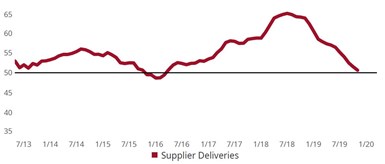Mild 91ĘÓƵ Index Contracts, Led By Drop in Backlogs
The November 91ĘÓƵ Businesses Index falls further as new orders, production contract.
Share






The Gardner Business Index (GBI): 91ĘÓƵ data indicated an accelerating contraction in November as the Index moved lower to 47.0. Index readings above 50 indicate expanding activity while values below 50 indicate contracting activity. The further away a reading is from 50, the greater the magnitude of change in business activity. review of the underlying index components observed that the Index, which is calculated as an average of its components, was supported by supplier deliveries, production, new orders, exports and employment. Only an accelerating contraction in backlogs pulled the Index lower.

Supplier Deliveries (3MMA)
In its history, the 91ĘÓƵ Index has rarely experienced simultaneously contracting activity among all its components. In the history of the GBI, which dates back to late-2011, supplier deliveries has only contracted during seven of those months.
All components registered contractionary readings in November — an occurrence last experienced in the third quarter of 2015. At that time, the 91ĘÓƵ Index was in the midst of a 21-month contractionary period that did not end until January 2017, marking the beginning of the most recent (and longest) manufacturing expansion since Gardner first began collecting data in late 2011.
During the third quarter of 2019, total new orders readings hovered around 50, indicating no change in total new orders activity while export readings reported contracting activity. The difference between the readings implied a potential mild expansion in domestic new orders. November’s near same readings for both measures suggest both are now contracting.
Related Content
-
Market Indicators Continue to Soften in 91ĘÓƵ
The overall metalworking index is down more than a point, but future business is up slightly.
-
91ĘÓƵ Activity Trends Down Again in June
The 91ĘÓƵ Index closed at 44.3 in June, down 1.2 points relative to May, marking a 2024 low.
-
91ĘÓƵ Index Continues Climb into 2025
Steady improvement is short of expansion but component readings and future outlook remain strong.
.jpg;width=70;height=70;mode=crop)











